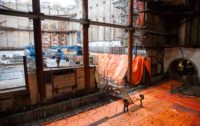Project Finance
Ontario Premier Pushes Pre-Election Toronto Transport Expansion

One of two new transit projects would link the city’s Ontario light rail line, announced in 2019, to Toronto Pearson International Airport.
Credit: Toronto Pearson International Airport
The Toronto area could see an infusion of more than $64 billion in new provincial spending on highway and transit projects over the next three decades under a long-term transportation plan released on March 10 by Ontario Premier Doug Ford.
The timing of the plan’s release is notable, coming a few months before provincial voters are to decide, likely on June 2, whether to re-elect Ford’s Progressive Conversative Party. The head of the opposition New Democrat party, Andrea Horwath, dismisses the funding infusion as a “gimmick.”
But Peter Smith, executive director of the Heavy Construction Association of Toronto, says the the plan is more than just election-year fodder. He says it comes in response to rapid growth in greater Toronto, with its population projected to grow by more than 40% over the next quarter century.
“It is real,” he said. “This is a huge financial commitment from the province and long overdue.” The province’s transportation plan includes a number of projects and other spending already in the works, with construction crews currently at work – or gearing up to start - on billions of dollars in various transit projects in Toronto and its environs.
But it also includes two new highway projects and two new transit projects, although the latter are still in conceptual stages.
Keeping up With Growth
One focus of the highway and transit projects is to ease lateral movement along the perimeter of the Toronto area, compared to the more typical focus of moving riders in and out of the city, said Nadia Todorova, executive director of the Residential and Civil Construction Alliance of Ontario.
The proposed Highway 413 would add a new four-to-six lane, 36-mile highway skirting the edges of Toronto, with connections to five different highways and 11 interchanges linked to city roads. The plan also discusses the potential to roll out light transit along the new highway route.
Bradford Bypass, the second major highway project proposed, involves construction of a 10-mile stretch of controlled access freeway to connect highways 400 and 404.
One of the two new transit projects would provide access to Toronto Pearson International airport—connecting the already planned Ontario Line to an east-west subway line and then back to the Ontario Line in a loop.
The second project outlines a light rail line across the city’s northern edge, to connect to suburbs southwest and east of Toronto, Burlington and Oshawa. A significant part of the new line would parallel Highway 407.
The huge proposed outlay on new transportation infrastructure comes as provincial and local officials scramble to keep up with the city's population surge. as well as a booming economy and real estate market.
Greater Toronto is expected to reach 10 million people by 2046, up from just over 7 million now, a nearly 41% rise.
“The new lines will help with lateral movement,” Todorova said. “It’s very forward thinking.”






